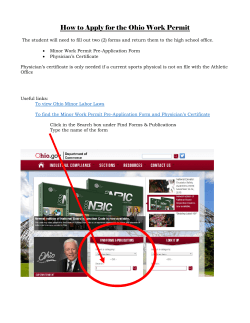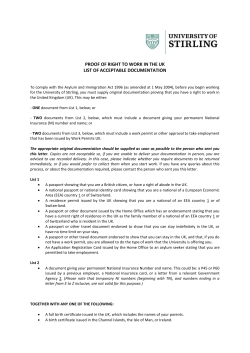
2014 Ecology and Waterway Permitting Training for Project Managers
2014 Ecology and Waterway Permitting Training for Project Managers Goals of This Training Increase knowledge Who is the Ecology and Waterway Permitting Office and what do they do? Five things every PM should know Other do(s) to decrease risk of project delays Environmental Services Division (ESD) Ecology and Waterway Permitting Office (EWPO) EWPO is responsible for evaluating INDOT project impacts to waterways and natural habitats. Our goal is to ensure INDOT compliance with a variety of environmental laws and regulations protecting ecological resources and waterways. The office is split into two main teams: Ecology and Waterway Permitting, and Stormwater. Manager: Saxe EcologyNathan and Waterway Permitting Division of Environmental Services Office Indiana Department of Transportation (317)232-0240 office nsaxe@indot.in.gov Ecology and Permitting Teams Ecology and Waterway Permitting VACANT – Southwest Team Lead Office Contact Lisa Herber Lisa Herber – Northeast Team Lead 317-232-5135 lherber@indot.in.gov Stormwater Team Rick Phillabaum – Team Lead 317-233-5151 rphillabaum@indot.in.gov Ecology and Southwest TeamWaterway Permitting Dave Glista – Crawfordsville Teams 317-234-5241 dglista@indot.in.gov Li Kang – Seymour 317-232-6766 lkang@indot.in.gov Crystal Rehder – Vincennes 317-233-2062 crehder@indot.in.gov Ecology Team and Waterway Permitting Northeast Sandy Bowman – LaTeams Porte 317-233-5568 sbowman@indot.in.gov Kristi Todd – Fort Wayne 317-234-8220 ktodd@indot.in.gov VACANT – Greenfield Contact Lisa Herber Ecology and Waterway Permitting Stormwater Team Kathy Allen – Northeast Teams 317-232-5361 kallen@indot.in.gov Michele Conyer – Southwest 317-232-5114 mconyer@indot.in.gov Shawn Slaymon – Landscape Architect 317-234-5475 sslaymon@indot.in.gov Ecology and Waterway Permitting Team Core responsibilities During project development Ecological surveys and Waters of the US Reports Prepare permit determinations Mitigation for waterway impacts Quality and completeness of waterway permit applications Coordinate with regulatory agencies throughout During construction – Perform site visits to evaluate compliance Post-construction – Mitigation site monitoring reports and any required remediation Stormwater Team Core Responsibilities Stormwater Pollution Prevention Plans (SWPPPs) Rule 5 Notices of Intent Performs site visits to ensure permit compliance Agency coordination Post-construction stormwater What Else Do We Do? INDOT guidance and policy development Landscape, Ecology, Permitting, Mitigation Design Manual, Permitting Manual, GIFE, Ecology Manual, Internal Checklists etc. Std. Specs., Special Provisions, Prequalification Criteria, etc. INDOT Reporting (FHWA, internal) Five Things Every PM Should Know Permits needed for your project Typical permitting timeframes Mitigation need/status for your project Designer involvement EWPO contact information Five Things Every PM Should Know Permits needed for your project Typical permitting timeframes Mitigation need/status for your project Designer involvement EWPO contact information Main Permitted Activities Main Permitted Activities Placement of fill w/in Waters of the United States Alteration to the cross-sectional area of a waterway Fill is soil, riprap, concrete, structures, etc. Temporary or permanent Streams and rivers Wetlands, ponds or lakes Streams and rivers Floodway or floodplain Land disturbance and erosion and sediment control Main Waterways Permitting Agencies US Army Corps of Engineers (USACE) Indiana Department of Environmental Management (IDEM) Indiana Department of Natural Resources (IDNR) Typical Permits: U.S. Army Corps of Engineers (Fill) Ind. Dept. of Environmental Management Section 404 Regional General Permit (RGP) Section 404 Nationwide Permit (NWP) Section 404 Individual Permits (IP) Section 401 Water Quality Certification (WQC) (Fill) Isolated Wetland Permit (Fill) Rule 5 – Erosion Control (Land Disturbance) Ind. Dept. of Natural Resources (Cross-sectional area) Construction in a Floodway Permit Navigable Waterways Permit Permits Required Less Often U.S. Army Corps of Engineers (Commercially navigable) Class V Injection Wells Sole Source Aquifers (Connection to groundwater) (St. Joseph Aquifer - groundwater) Section 402 (NPDES) Permit Rule 13 Statewide Permit (Sewer & septic systems) (Individual storm water permit) Navigable Waterways Permit Dewatering Well Installation Water Well Abandonment Lake Preservation Act Lowering of Ten Acre Lakes Act (Work IN a navigable waterway) (Significant water withdrawal facility) (Closure of water wells) (Piers, seawalls, dredging in lakes) (Ditching or draining affecting lake level) Indiana Dept. of Environmental Management Section 9 Bridge Permit Environmental Protection Agency (EPA) (Work IN a navigable waterway) (Work ON a legal levee) United States Coast Guard Section 10 Permit USACE Levee Permit Ind. Dept. of Natural Resources Five Things Every PM Should Know Permits needed for your project Typical permitting timeframes Mitigation need/status for your project Designer involvement EWPO contact information Typical Waterway Permit Completion Times Agency Permit Type Number of months application packages need to be given to ES prior to RFC Date USACE 404 Individual Permit* 12-18 months USACE 404 Nationwide Permit 3 months USACE 404 Regional General Permit (RGP)* 4-6 months IDEM 401 with more than .1 acre OR > 300 linear ft. of impacts* 7 months IDEM 401 with less than .1 acre AND < 300 linear ft. of impacts 4 months IDEM Rule 5 4 months IDEM Isolated Wetlands* 7 months DNR All permit types by DNR* 9 months * May need mitigation in order to submit the permit application Typical Permit Timeline Factors Fixed factors Flexible factors Public notice requirements Statutory review periods Average agency turnaround times Interagency staffing agreements Other considerations Complexity and agency familiarity with project Application quality and completeness Mitigation need - on-site vs. off-site Five Things Every PM Should Know Permits needed for your project Typical permitting timeframes Mitigation need/status for your project Designer involvement EWPO contact information Project Impact Reduction Sequence of impact reduction measures 1. Avoidance – stay away from impacts 2. Minimization – reduce impacts such that mitigation is not needed 3. Mitigation – for unavoidable impacts after minimization (streams and wetlands) Self-mitigating or on-site Off-site Waterways Mitigation USACE and IDEM Mitigation Thresholds When cumulative impacts to waters (streams and adjacent wetlands) are > 0.10 acre Any loss of stream length as measured along the centerline of the stream When cumulative permanent impacts to waterways exceeds 300 linear feet When encapsulation of a waterway is > 150 linear feet (including pipe extensions) Any non-exempt impacts to isolated wetlands Typical Mitigation Ratios Wetlands (acres) Farmed/open water 1:1 Emergent 2:1 Scrub/shrub 3:1 Forested 4:1 Exceptional, Unique, Critical Wetlands >4:1 Stream mitigation (linear ft.) Buffer acreage Contingency acreage/linear ft. 1:1 Mitigation – It Takes Time! Locate suitable site within impact area On-site or purchase/easement off-site from willing seller Site design Mitigation and monitoring plan NEPA? ROW acquisition Permits? Mitigation – It Requires Funds! Mitigation site costs Design Site suitability survey, topographic survey, NEPA, geotech, design, permitting, ROW eng., acquisition, contract preparation Construction Post-construction At least five years of monitoring Site maintenance/rehab Site failure/replacement Five Things Every PM Should Know Permits needed for your project Typical permitting timeframes Mitigation need/status for your project Designer involvement EWPO contact information The Project Development Process During NEPA Identify and evaluate alternatives Complete Phase 1 Ecological Surveys Project consultant/district env. scoping Includes Waters of the US report Review Stage 1 detailed design plans for environmental impacts Project consultant/district env. scoping Preliminary permit determination The Project Development Process Develop Stage 2 Detailed Design and Plans Request a permit determination from Ecology and Permitting Specialist in ES Avoidance and minimization Mitigation site investigation/design The Project Development Process Stage 3 – Complete Preferred Alternative Avoidance and minimization Submit final waterway permit applications Ecology and Permitting Specialist – ES ES will review/submit permit applications to regulatory agencies The Project Development Process Prepare final tracings package Prepare final special provisions/plans Should include and reflect all waterways permits and special conditions, commitments etc. Jurisdictional waterways should be identified on the plans Five Things Every PM Should Know Permits needed for your project Typical permitting timeframes Mitigation need/status for your project Designer involvement EWPO contact information Ecology and Waterway Permitting Office See handout Team lead assignment areas Ecology and Permitting Specialists by district Stormwater Specialist by district Contact us—Map of areas and staff: http://www.in.gov/indot/2522.htm Project Managers Do(s) Do read your NEPA document Do read your Waters of the US Report Identifies potential wetland/stream resources early Identifies locations of water resources Avoidance and minimization Do request a formal permit determination Plans & Waters of the US Report required Project Managers Do(s) Do remember: design changes AFTER permit application submittal may start the permitting clock over Design waterways’ structures and adjacent slopes as early as possible Project Managers Do(s) Do understand the potential risks associated with project typecasting Assumed lack of impacts due to project type Sm. structure replacement example Simple Structure Replacement? Actual Proposed Impacts Project Managers Do(s) Do get involved with permit violations during construction One project voice to assist/assure resolution Can make decisions that decrease risk of: Regulatory enforcement Claims from the contractor Conflicting ―goals‖ on the project Site Visits and Inspections for Compliance INDOT site visits IDEM Rule 5 inspections During construction season Technical assistance for permit compliance Year-round Initial and follow-up May result in violation Other agencies Typically complaint based Resources ES Website (includes Permits Manual) http://www.in.gov/indot/2522.htm Application Guidance IDEM: http://www.in.gov/idem/4221.htm IDNR: http://www.in.gov/dnr/water/2455.htm USACE: http://www.usace.army.mil/CECW/Pages/cecwo_reg.aspx National Highway Institute Training Opportunities http://www.nhi.fhwa.dot.gov/training/brows_catalog.aspx Resources Environmental Waterway Permits System (EWPS database) – live since late 2011 Accessible as a viewer through ITAP Request access Project by project viewing of status of permits Canned reports being developed in the MIP (INDOT Answers) SPMS data pulled into database
© Copyright 2025










